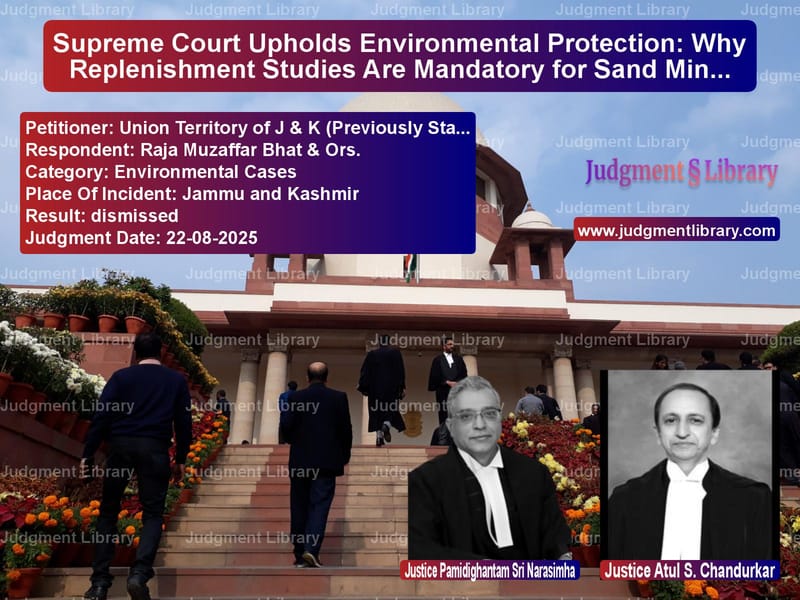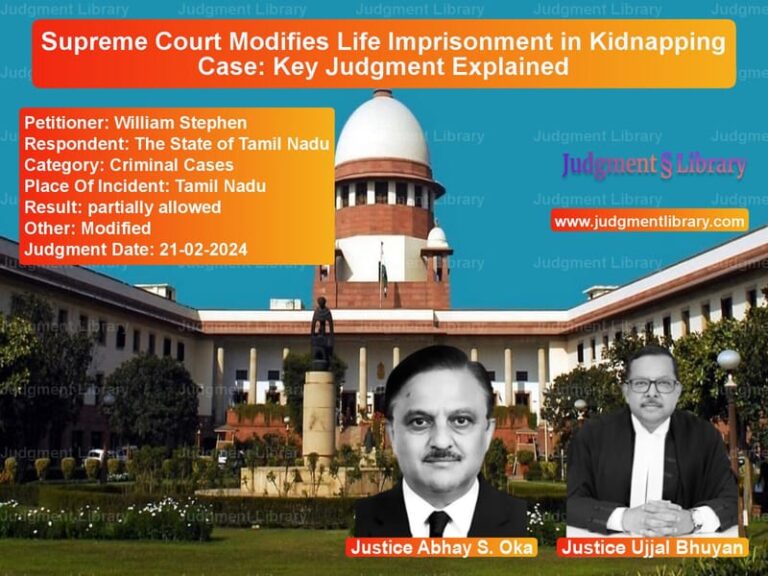Supreme Court Upholds Environmental Protection: Why Replenishment Studies Are Mandatory for Sand Mining
In a landmark judgment that reinforces India’s commitment to environmental protection, the Supreme Court has delivered a powerful message about the importance of sustainable development. The case involving sand mining in Jammu and Kashmir has set a crucial precedent that will shape how natural resources are managed across the country. This ruling comes at a time when the demand for construction materials is at an all-time high, creating constant pressure on our river systems and ecological balance.
The story begins in the beautiful valleys of Jammu and Kashmir, where the National Highway Authority of India awarded a contract for constructing a 4-lane bypass around Srinagar City. Like any major infrastructure project, this required substantial amounts of sand and gravel for construction. The project proponent identified several blocks in the Shaliganga Nallah riverbed for mining operations and applied for environmental clearances to begin extraction.
What followed was a legal battle that would ultimately reach the highest court of the land, raising fundamental questions about how we balance development needs with environmental protection. The Jammu and Kashmir Expert Appraisal Committee initially rejected the mining proposals, noting that the proposed area was already over-exploited and depleted due to heavy illegal mining. More importantly, they observed that the District Survey Report prepared for the concerned district was not formulated as per guidelines and needed revision to include replenishment data.
However, after receiving a ‘Fit for Mining Certificate’ from the Geology and Mining Department, the project proponent reapplied for environmental clearance. This time, despite reiterating that the District Survey Report was not prepared according to guidelines, the Expert Appraisal Committee recommended grant of environmental clearance. The State Environment Impact Assessment Authority granted the clearance with certain conditions, including restricting mining depth to maximum of 1 meter in view of non-availability of replenishment data in the District Survey Report.
This decision was challenged before the National Green Tribunal by environmental activist Raja Muzaffar Bhat, who argued that the environmental clearances were granted without proper consideration of environmental norms. The Tribunal allowed the appeal and set aside the environmental clearances, leading to the present appeals before the Supreme Court.
The Legal Framework for Environmental Protection
To understand the significance of this judgment, we need to appreciate the legal framework that governs environmental protection in India. The Environment (Protection) Act, 1986 is a comprehensive legislation enacted with the object of protecting and improving our environment. Under this Act, the government issued various notifications that make environmental clearance mandatory for specified projects, including mining activities.
The evolution of environmental law in India has been particularly significant in the context of sand mining. In 2012, the Supreme Court in the landmark case of Deepak Kumar v. State of Haryana examined the legality of mining leases granted without proper environmental appraisal. The Court made crucial observations that would shape future regulations. The Court stated: “Sand mining on either side of the rivers, upstream and instream, is one of the causes for environmental degradation and also a threat to the biodiversity. Over the years, India’s rivers and riparian ecology have been badly affected by the alarming rate of unrestricted sand mining which damage the ecosystem of rivers and the safety of bridges, weakening of riverbeds, destruction of natural habitats of organisms living on the riverbeds, affects fish breeding and migration, spells disaster for the conservation of many bird species, increases saline water in the rivers, etc.”
The Court further emphasized that “We find that it is without conducting any study on the possible environmental impact on/in the riverbeds and elsewhere the auction notices have been issued. We are of the considered view that when we are faced with a situation where extraction of alluvial material within or near a riverbed has an impact on the river’s physical habitat characteristics, like river stability, flood risk, environmental degradation, loss of habitat, decline in biodiversity, it is not an answer to say that the extraction is in blocks of less than 5 ha, separated by 1 km, because their collective impact may be significant, hence the necessity of a proper environmental assessment plan.”
In response to this judgment, the government introduced significant amendments to the environmental clearance process through the Environment Impact Assessment Notification, 2016. This notification established District Level Environment Impact Assessment Authority and District Expert Appraisal Committee specifically for dealing with mining of minor minerals. Most importantly, it mandated the preparation of District Survey Reports that would form the basis for granting environmental clearances.
The Critical Importance of Replenishment Studies
At the heart of this case lies the concept of replenishment studies. The Supreme Court explained this crucial concept in simple terms: “Just as forest conservation requires assessment of tree growth rate before permitting timber harvesting to ensure that felling of trees does not exceed tree growth, a replenishment study enables us to take an informed decision as to whether sand mining can be permitted without degrading the rivers’ natural balance.”
The Court relied on the Sand Mining Guidelines 2020 which explain why replenishment studies are so important: “The need for replenishment study for river bed sand is required in order to nullify the adverse impacts arising due to excessive sand extraction. Mining within or near riverbed has a direct impact on the stream’s physical characteristics, such as channel geometry, bed elevation, substratum composition and stability, in-stream roughness of the bed, flow velocity, discharge capacity, sediment transport capacity, turbidity, temperature etc. Alteration or modification of the above attributes may cause an impact on the ecological equilibrium of the riverine regime, disturbance in channel configuration and flow-paths. This may also cause an adverse impact on in-stream biota and riparian habitats. It is assumed that the riparian habitat disturbance is minimum if the replenishment is equal to excavation for a given stretch. Therefore, to minimize the adverse impact arising out of sand mining in a given river stretch, it is imperative to have a study of replenishment of material during the defined period.”
The Court emphasized that without proper replenishment studies, we cannot determine how much sand can be sustainably extracted from a river system. The guidelines prescribe a detailed methodology for conducting these studies, including four surveys throughout the year to understand how much sand is naturally replenished after monsoon seasons.
The Court’s Analysis and Decision
The Supreme Court conducted a thorough analysis of the legal framework and its application to the facts of the case. The Court noted that the Jammu and Kashmir Expert Appraisal Committee itself had acknowledged that the District Survey Report was not prepared according to guidelines and needed revision to include replenishment data. Despite this acknowledgment, the Committee proceeded to recommend environmental clearance.
The Court made a significant observation about this approach: “The J&K EAC committed a serious error in proceeding further with the DSR once it realised that it is not formulated as per the MoEF&CC Notification 2016 and 2016 and 2020 Sand Mining Guidelines and also when the replenishment data is not complete. Further, the half-hearted approach adopted by the J&K EAC is evident from its final recommendation for grant of EC with validity of only three years from the date of commencement of the mining operations duly certified by the District Mineral Officer concerned with intimation to the JKEIAA and JKPCB in view of non-availability of replenishment data.”
The Court was particularly critical of the compromise made by the regulatory authorities: “It is unfortunate that J&K EIAA compromised with regulatory integrity by granting the environment clearances (EC) on the basis of a DSR without a replenishment report. The compromise sought to be achieved by permitting the project proponent to go ahead with a ‘restricted mining depth of maximum 1 meter and bulk density of 2.0 for production of the mineral and supplying it to maximum production of 34800 mt in view of non-availability of replenishment data’ is unacceptable. The illegality committed by the J&K EAC in so recommending is accentuated with the J&K EIAA in granting EC. This is how regulatory failure occurs.”
The Court upheld the decision of the National Green Tribunal and dismissed all appeals, establishing a crucial legal principle: “We hold that a District Survey Report without a proper replenishment study is equally untenable.”
The Bigger Picture: Sustainable Development
This judgment goes beyond the specific case of sand mining in Jammu and Kashmir. It represents a significant step forward in India’s environmental jurisprudence, reinforcing the principle of sustainable development. The Court recognized the global context of sand mining, noting that “Demand for construction-grade sand is growing at a tremendous rate and it is said that the world is expected to run out of this resource by 2050.”
The Court explained the environmental consequences of unregulated sand mining: “Even under controlled circumstances, the practice of extracting sand from the riverbed and banks impacts the environment. In the physical environment, the primary effects are riverbed widening and lowering. In the biological environment, the overarching effect is a reduced biodiversity and stretches from the aquatic and shoreline flora and fauna to the whole floodplain area.”
This judgment serves as a reminder that development and environmental protection are not mutually exclusive. Rather, sustainable development requires that we carefully assess the environmental impact of our activities and take measures to minimize harm. The Court’s insistence on proper scientific studies before granting environmental clearances ensures that decisions about resource extraction are based on data rather than assumptions.
The Supreme Court’s judgment in this case represents a significant victory for environmental protection in India. By making replenishment studies mandatory for sand mining operations, the Court has ensured that future development projects will have to account for their environmental impact in a scientific and transparent manner. This decision will help protect our rivers and ecosystems for generations to come, while still allowing for responsible development that meets the needs of our growing economy.
As the Court rightly observed, without proper scientific studies, we cannot make informed decisions about sustainable extraction limits. This judgment reinforces the fundamental truth that we cannot sacrifice long-term environmental health for short-term economic gains. It’s a balance that must be carefully maintained, and the Supreme Court has provided clear guidance on how to achieve this balance in the context of sand mining and natural resource management.
Petitioner Name: Union Territory of J & K (Previously State of Jammu & Kashmir) & Anr..Respondent Name: Raja Muzaffar Bhat & Ors..Judgment By: Justice Pamidighantam Sri Narasimha, Justice Atul S. Chandurkar.Place Of Incident: Jammu and Kashmir.Judgment Date: 22-08-2025.Result: dismissed.
Don’t miss out on the full details! Download the complete judgment in PDF format below and gain valuable insights instantly!
Download Judgment: union-territory-of-j-vs-raja-muzaffar-bhat-&-supreme-court-of-india-judgment-dated-22-08-2025.pdf
Directly Download Judgment: Directly download this Judgment
See all petitions in Environmental Cases
See all petitions in Judgment by P.S. Narasimha
See all petitions in Judgment by Atul S. Chandurkar
See all petitions in dismissed
See all petitions in supreme court of India judgments August 2025
See all petitions in 2025 judgments
See all posts in Environmental Cases Category
See all allowed petitions in Environmental Cases Category
See all Dismissed petitions in Environmental Cases Category
See all partially allowed petitions in Environmental Cases Category







